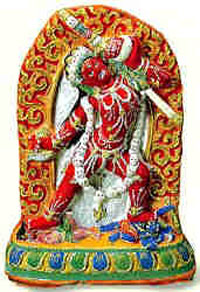Tshatsha, a literal translation from a Sanskrit word which mean "copy" in English, stands for small clay sculptures cut from a mold, including mini-statues of Buddha, stupas or Buddhist scriptures. Usually, they are put inside large stupas or special shrines (tsha-kang). They can also be found on top of Mani stones flanked by prayer flags along tracks, on the revered snow-peaks or in sacred caves. The Tibetans carry them in small amulet boxes to guard against evil.
Tshatshas are believed to have come from India together with Buddhism. Although most tshatshas are made of clay, there are also wooden or stone ones. The former are used to fill the stupas, with some are placed on top of the Mani stones or in special shrines, while most of the latter are placed in Buddhist shrines or altars.
Tshatshas, whether ancient or modern, generally fall into two categories in terms of their forms: relief sculptures, including high and low reliefs, made with a one-sided mold; and round sculptures that are made with a double- sided mold.
To make a tshatsha, first a mold, an indispensable item known as tsha-shi-gong in Tibetan, has to be made. Most molds are made of bronze or brass, and those made of porcelain, paper, or wood are rare and hence especially precious.
Once the mold is made, one can begin to make a clay tshatsha, a process that has been compared to working with the popular children's toy of plasticene (named after the famous trademark).
First step, a lump of clay is stuffed into the mold after being rolled into a clay pie. Then, a pit is made within which several grains of the highland barley (grown in Tibet and Qinghai in West China) are placed. The process, known as filling the scripture (Zhuangzang in Chinese), is believed to be able to give superhuman strength to the clay sculptures. Next, the clay is pressed so that its surface will be smooth and the design pattern clear. A pedestal is modeled by hand in the third step.
When all the above is done, the moist clay tshatsha is taken out from the mold and placed in sunshine to dry off, completing the process. This is called the lost wax method, which was considered the most advanced technique more than a millennium ago. It is still in use today to make delicate modern sculptures and replicas of antiques.
Since all the tshatshas are molded, they are not too large in size, hence their name "little statues of Buddha". By far, the largest one of those excavated measures no more than an inch in both width and height and the smallest one is no larger than a thumbnail. In most cases, they are about 9 centimeters in width and 7 inches height.
Though small, tshatsha serves the same purposes as other Buddhist forms, such as the mural painting and thangka. Buddhists recognize them as symbols of Buddhist merits, and use them to express their adoration and reverence for the Buddha, and their explanation of and devotion to the Buddhist doctrines, as well as their aspiration for riches and honor.
The tshatshas are colored with traditional Tibetan pigment, which is in fact a kind of mineral paint traditionally made by mixing different amounts of minerals so that they still retain their bright original colors after hundreds of years.
Though made with the same techniques, tshatshas vary greatly from place to place. Tshatshas found in the stupas in Jiama County, dating back to over 600 years ago in the Yuan Dynasty (1271-1368 AD), feature three-dimensional patterns in high relief; details like figures and background decorations are also emphasized.
The most distinctive aspect of these tshatshas is their large size, as most of them are 10 centimeters high and 8 centimeters wide, with the largest reaching as much as 26 centimeters in height and 20 centimeters in width. These tshatshas are believed to be of great value for the research on the Tibetan Buddhist art in the Yuan Dynasty.
Compared with tshatshas found in other places, those found in Xialu Temple are said to be unique and worthy of collection, as they have the largest variety in terms of the ages, the patterns and the styles as well as the colors.
Tshatshas also abound in Sajia Temple, and are famed for their delicacy and exquisiteness. Most of them are burned into colors such as red, gray or black. There are also tshatshas with two colors, an uncommon feature.
In the Northern Sajia Temple, tshatshas with typical Indian or Nepalese artistic features can be found, which were put in the stupas when the temple was built nearly a thousand years ago. Therefore, they are referred to as having matchless artistic and historical value.
Due to its long history and unique artistic charm as well as the mysterious cultural implications, tshatsha has grown into a special category, arousing the interests of numerous experts, artists and collectors. Over the years, tshatshas, with its rich implications, various design patterns, long history and different artistic styles have become a treasured collectible item.
(China Daily August 6, 2007)




